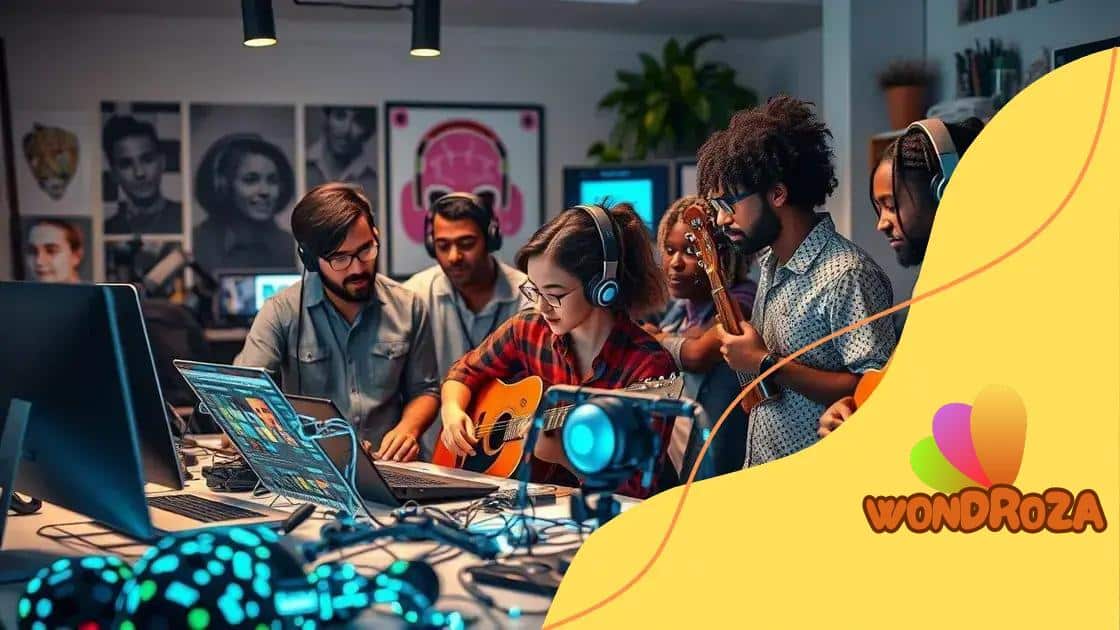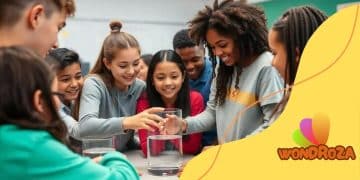The role of AI in transforming the creative industries

The role of AI in transforming the creative industries involves enhancing artistic expression through collaboration, while also posing challenges regarding originality and authorship within an evolving technological landscape.
The role of AI in transforming the creative industries is not just a trend; it’s reshaping how we think about creativity. Have you ever wondered how new technologies can amplify artistic expression? Let’s dive into this fascinating transformation.
Understanding the impact of AI on creativity
Understanding the impact of AI on creativity is crucial in today’s ever-evolving artistic landscape. As technology advances, its influence on how we create art, music, and literature becomes more apparent.
By leveraging AI, artists are able to expand their creative boundaries and explore new avenues of expression. AI tools can analyze vast amounts of data, providing insights that would have taken humans much longer to uncover.
How AI Tools Enhance Creative Processes
Creative professionals are using AI in various ways to enhance their work. Some of these methods include:
- Generating unique artwork using algorithms
- Composing music with AI-assisted tools
- Facilitating brainstorming sessions with intelligent suggestions
- Improving photo editing through smart filters
The ability to automate certain tasks allows artists to focus more on the vision behind their work. This collaboration between human and machine can lead to innovative outcomes that push the limits of traditional creativity.
The Balance Between Technology and Human Touch
Despite the advancements, it is essential to find a balance between technology and human creativity. Many argue that while AI can assist, the unique emotional connection of a human artist remains irreplaceable. The best results often come from a synergy between the two.
The impact of AI also opens up discussions about authenticity and ownership in creative fields. As AI continues to develop, questions arise about the rights of AI-generated content and its place in the art world. Artists must navigate these complexities while embracing the benefits of AI-driven tools.
Innovations driven by AI technologies
Innovations driven by AI technologies are transforming industries at an unprecedented pace. They not only enhance productivity but also introduce novel ways of thinking and creating. Many sectors are leveraging these innovations to improve efficiency and discover unique solutions to complex problems.
One of the most exciting aspects of AI is its ability to assist human creativity. AI applications are making it easier for creators to explore different styles, ideas, and techniques without the usual limitations.
Examples of AI Innovations
Several AI-driven innovations are changing how we perceive creativity:
- Generative Design: This is commonly used in architecture and product design, where AI algorithms create thousands of design alternatives based on specific parameters.
- Content Creation: AI can write articles, generate artwork, and even compose music, enabling creators to augment their artistic abilities.
- Personalized Experiences: AI helps tailor content to individual preferences, allowing for a more engaging experience in areas like gaming and digital marketing.
- Predictive Analytics: Data-driven insights enable creators to make informed decisions, enhancing the overall quality of their projects.
As these technologies evolve, they continue to provide tools that push the boundaries of creativity. AI not only serves as a collaborator but also a source of inspiration, allowing creators to seek paths previously unimagined.
The Role of Collaboration Between Humans and AI
The interplay between humans and AI reinforces the notion that technology can enhance, rather than replace, the creative process. Artists are finding new ways to merge their vision with AI capabilities, resulting in groundbreaking pieces of art. This collaboration opens doors to innovative genres and styles that reflect a fusion of human emotion and machine learning. As these two forces work together, the opportunities for groundbreaking work become limitless.
Case studies of successful AI integration

Case studies of successful AI integration highlight how organizations have effectively used technology to boost creativity and productivity. These real-world examples show the potential of AI in diverse creative sectors.
One notable instance involves a major film studio that used AI to analyze scripts and suggest plot improvements. By processing vast amounts of data from previous successful films, the AI tool helped the writers refine their narratives, leading to a more engaging final product.
AI in Music Production
In the music industry, AI technologies have transformed how artists compose and produce songs. For example:
- Amper Music: This AI platform allows musicians to create custom music tracks quickly, helping them focus on the artistic side of production.
- Endlesss: This collaborative music creation app uses AI to help musicians jam and create beats in real-time, enhancing the collaborative experience.
- IBM Watson: This AI analyzes musical patterns and can even help create songs that resonate with listeners by predicting what styles might be popular.
These technologies not only streamline the creative process but also open the door for new styles and collaborations between artists and machines.
AI in Visual Arts
The visual arts have also benefited from AI integration. Artists are using AI tools to push the limits of their creativity. One striking example is the work of artists who collaborate with AI to generate unique pieces of art.
By using algorithms that learn from existing artworks, these artists can create pieces that combine various styles or generate entirely new concepts. DeepArt is an example where AI transforms photos into artworks emulating famous painting styles, making art more accessible.
Through these case studies, it becomes clear that AI can enhance the creative process, offering novel tools that inspire artists and creators to explore uncharted territories.
Challenges faced by creatives using AI
Challenges faced by creatives using AI highlight the complexities of integrating advanced technology into artistic processes. While AI has many benefits, there are obstacles that artists and creators must navigate.
One of the main concerns is the potential loss of originality. As AI systems analyze existing works to generate new content, some creatives worry that their unique style may be influenced or diluted by algorithms. This raises the question: how can artists maintain their voice in a landscape dominated by machine-generated ideas?
Intellectual Property Issues
Another significant challenge revolves around intellectual property rights. When AI generates art or music, who owns the final product? Is it the artist who guided the AI, the developer of the AI tool, or the AI itself? These questions need clear answers as artists strive to protect their work.
Additionally, artists face competition from AI-generated content. As technology advances, AI can create high-quality work faster and at a lower cost than human artists. This might lead to fewer opportunities for creatives and force them to adapt to a landscape where machine-generated works are prevalent.
The Learning Curve
The learning curve for using AI tools can also be steep. Many creatives may not have the technical skills required to effectively utilize these technologies. This can lead to frustration and a feeling of being left behind in a rapidly evolving industry.
However, embracing AI requires a willingness to experiment and learn. By taking the time to understand how these tools work, artists can find ways to enhance their creativity rather than replace it. Overall, though AI offers exciting opportunities, it brings significant challenges that creatives must address.
The future of creativity in an AI-driven world
The future of creativity in an AI-driven world promises exciting developments as technology continues to evolve. Artists, writers, and musicians are beginning to embrace AI as a valuable partner in the creative process. As this technology advances, it raises intriguing possibilities for what creativity can achieve.
One aspect of this future involves enhanced collaboration. AI tools can assist creators by suggesting ideas, generating drafts, or even composing music. By handling repetitive tasks, AI frees artists to focus on the core elements of their work.
Expanding Creative Boundaries
Additionally, AI opens doors to new styles and methods of creation. For example:
- Generative art: Artists can use algorithms to produce unique visual elements, expanding their artistic range.
- Interactive installations: AI can create immersive experiences that respond to audience engagement, transforming how art is experienced.
- Personalized content: Writers can tailor stories to individual preferences, making literature more engaging for readers.
Such innovations lead to a landscape where creativity is more inclusive and diverse. People from various backgrounds can use AI to express themselves in ways that were previously unattainable.
Challenges and Ethical Considerations
However, alongside these opportunities, challenges remain. Questions about authorship and authenticity arise as AI systems create new content. How do we define creativity when machines are involved? Addressing these ethical considerations will be crucial as we navigate the future of creativity.
Moreover, balancing technology with human emotion is essential. The heart of creativity lies in personal expression, and AI must support this without overshadowing it. As we look forward, a partnership between humans and machines can lead to an extraordinary new era of creativity.
FAQ – Questions about the role of AI in transforming the creative industries
How does AI enhance creativity for artists?
AI provides tools that assist artists in generating ideas, improving designs, and even composing music, allowing for greater creativity and exploration.
What are potential challenges creatives face with AI?
Creatives may struggle with issues of originality, authorship, and competition from machine-generated content, which can impact their work.
Can AI replace human creativity?
AI is a tool that can enhance human creativity, but it cannot replace the unique emotional expression and perspective that human artists bring to their work.
What is the future of creativity in an AI-driven world?
The future suggests a collaborative environment where AI and human creativity coexist, leading to innovative forms of art and new opportunities for expression.





